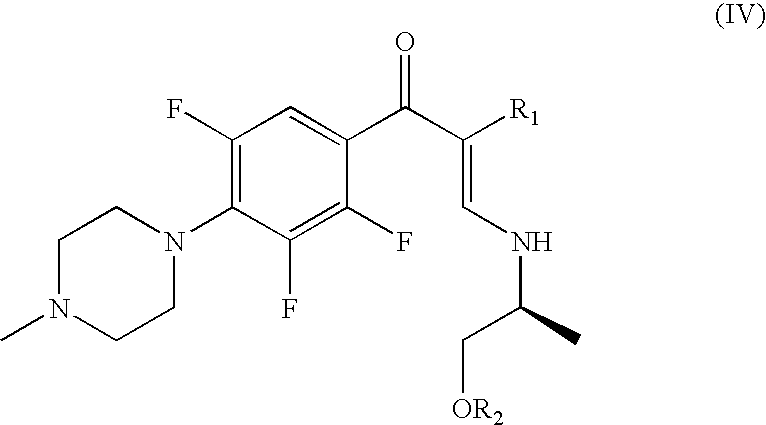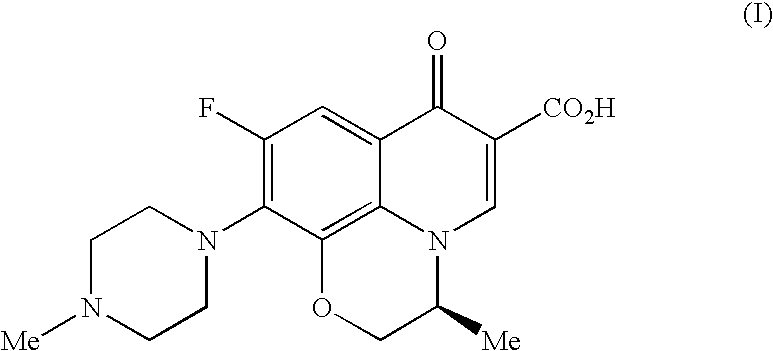Process for the preparation of an antibacterial quinolone compound
a technology of quinolone compound and quinolone, which is applied in the field of levoxacin, can solve the problems of difficult scale-up and scaling-up of chirality, and low purity and yield, and achieves the effect of saving and cost-effectiveness
- Summary
- Abstract
- Description
- Claims
- Application Information
AI Technical Summary
Benefits of technology
Problems solved by technology
Method used
Image
Examples
example 1
ethyl 3-oxo-3-(2,3,5-trifluoro-4-(4-methylpiperazin-1-yl)phenyl)propanoate (compound of formula (III) where R1 is COOEt)
[0053]To a solution of 12 g (45.5 mmol) of ethyl 3-oxo-3-(2,3,4,5-tetrafluorophenyl) propanoate in 100 mL of THF, 10 mL (90.1 mmol) of 1-methylpiperazine were added and the mixture heated at reflux for 2 hours. The solvent was distilled under vacuum and the residue was extracted with ethyl acetate and water. The organic phases were distilled under vacuum to obtain 14.9 g of the title compound as an oil in 95% yield.
[0054]RMN 1H(CDCl3), δ(ppm) Tautomers keto-enol: 1.23 (t, 3H); 2.30 (3H, s); 2.48 (4H, m, piperazine); 3.36 (4H, m, piperazine); 3.86 (2H, d); 4.20 (2H, q); 5.8 (1H, s); 7.30-7.50 (1H, m).
example 2
(S)-ethyl 3-(1-hydroxypropan-2-ylamino)-2-(2,3,5-trifluoro-4-(4-methylpiperazin-1-yl)benzoyl)acrylate (compound of formula (IV) where R1 is COOEt and R2 is H)
[0055]To a solution of 14.9 g (43.3 mmol) of ethyl 3-oxo-3-(2,3,5-trifluoro-4-(4-methylpiperazin-1-yl)phenyl)propanoate in 100 mL of toluene, 10 mL (75.3 mmol) of dimethyl acetal of N,N-dimethylformamide were added and the mixture heated at reflux for 2 and a half hours. The crude reaction mixture was cooled to room temperature, washed twice with a solution of sodium bicarbonate and the organic phase was distilled under vacuum to dryness. The resultant crude containing ethyl 2-(3,5-difluoro-4-(4-methylpiperazin-1-yl)benzoyl)-3-(dimethylamino)acrylate was dissolved in 150 mL of ethanol, cooled to 15-20° C. and 3.6 mL (45.2 mol) of L-alaminol were added. After 1 and a half hours, the ethanol was evaporated under vacuum and extracted with ethyl acetate and washed with sodium bicarbonate solution to give 17.8 g of the title compoun...
example 3
(S)-ethyl 3-(1-acetoxypropan-2-ylamino)-2-(2,3,5-trifluoro-4-(4-methylpiperazin-1-yl)benzoyl)acrylate (compound of formula (IV) where R1 is COOEt and R2 is CH3CO)
[0057]15.3 g (35.6 mol) of the oil obtained in EXAMPLE 2 were dissolved in 150 mL of dichloromethane and after adding 6.6 mL (47.3 mmol) of triethylamine the mixture was cooled to 0-5° C. and 4.4 mL (61.8 mmol) of acetyl chloride were added over 30 minutes. The reaction was left at 5-10° C. for 1 and a half hours, and then the solvent was evaporated under vacuum to obtain an oil in almost quantitative yield.
[0058]RMN 1H(CDCl3), δ(ppm) Cis and Trans isomers: 0.9-1.1 (3H, t); 1.4 (3H, d); 2.1 (3H, s); 2.35 (3H, s); 2.55 (4H, m, piperazine); 3.3 (4H, m, piperazine); 3.7 (1H, m); 4.0-4.1 (4H, m); 6.9 (1H, m); 8.2 (1H, d).
PUM
| Property | Measurement | Unit |
|---|---|---|
| w/w | aaaaa | aaaaa |
| pKa | aaaaa | aaaaa |
| temperature | aaaaa | aaaaa |
Abstract
Description
Claims
Application Information
 Login to View More
Login to View More - R&D
- Intellectual Property
- Life Sciences
- Materials
- Tech Scout
- Unparalleled Data Quality
- Higher Quality Content
- 60% Fewer Hallucinations
Browse by: Latest US Patents, China's latest patents, Technical Efficacy Thesaurus, Application Domain, Technology Topic, Popular Technical Reports.
© 2025 PatSnap. All rights reserved.Legal|Privacy policy|Modern Slavery Act Transparency Statement|Sitemap|About US| Contact US: help@patsnap.com



